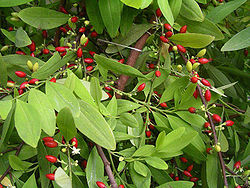Coca plant
| Coca | |
|---|---|

Erythroxylum novogranatense var. novogranatense leaves and berries
|
|
| Product name | Coca |
| Source plant(s) | Erythroxylum coca var. coca, Erythroxylum coca var. ipadu, Erythroxylum novogranatense var. novogranatense, Erythroxylum novogranatense var. truxillense |
| Part(s) of plant | leaf |
| Geographic origin | Andes |
| Active ingredients | Cocaine, benzoylecgonine, ecgonine, others |
| Legal status |
|
Coca is any of the four cultivated plants in the family Erythroxylaceae, native to western South America.
The plant is grown as a cash crop in Argentina, Bolivia, Colombia, Ecuador, and Peru, even in areas where its cultivation is unlawful. There are some reports that the plant is being cultivated in the south of Mexico as a cash crop and an alternative to smuggling its recreational product cocaine. It also plays a role in many traditional Andean cultures as well as the Sierra Nevada de Santa Marta (see Traditional uses). Coca is known throughout the world for its psychoactive alkaloid, cocaine. The alkaloid content of coca leaves is low, between 0.25% and 0.77%. This means that chewing the leaves or drinking coca tea does not produce the high (euphoria, megalomania, depression) people experience with cocaine. Coca leaf extract had been used in Coca-Cola products since 1885, with cocaine being completely eliminated from the products in or around 1929. Extraction of cocaine from coca requires several solvents and a chemical process known as an acid / base extraction, which can fairly easily extract the alkaloids from the plant.
The coca plant resembles a blackthorn bush, and grows to a height of 2 to 3 metres (7 to 10 feet). The branches are straight, and the leaves are thin, opaque, oval, and taper at the extremities. A marked characteristic of the leaf is an areolated portion bounded by two longitudinal curved lines, one line on each side of the midrib, and more conspicuous on the under face of the leaf.
...
Wikipedia
